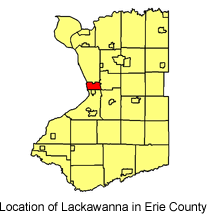 City Hall
City Hall
714 Ridge Road
Lackawanna, New York 14218
PH: 716-827-6486
FAX: 716-825-1874
Court Office Hours: Monday-Friday 8:30am-4:30pm
City Justice:
Frederic J. Marrano
Louis P. Violanti
District Attorney:
As assigned by the Erie County District Attorney Justice Court Bureau.
Court Clerk:
Lisa Gauthier
Court Schedule:
Drug Court:
Monday 2:00pm
Traffic Court:
Thursday and Friday 9:00am
Civil, Evictions, Commercial and Small Claims:
Thursday 9:00am-2:00pm
Friday 9:00am
Map:
You may not know:
Lackawanna is a city in Erie County, New York, U.S., located just south of the city of Buffalo in the western part of New York state. The population was 19,064 at the 2000 census. The name derives from the Lackawanna Steel Company. It is part of the Buffalo-Niagara Falls metropolitan area. The city of Lackawanna is in the western part of the county.
The city of Lackawanna has a mayor-council form of government. A councilman is elected for each of the four wards of the city. The mayor and council president are elected at large. Fire and police services are also provided by city run departments.
Originally part of the Buffalo Creek Reservation, the area was not open to settlement until 1842 when the land was sold by the Seneca Indians. In 1851 the town of Seneca was formed, the name was changed to West Seneca in 1852, with the area now known as Lackawanna being called West Seneca or Limestone Hill.
Lackawanna was a center of steel manufacture throughout most of the 20th century. In 1899 all the land along the West Seneca shore of Lake Erie was purchased by the Lackawanna Steel Company. Construction was started in 1900 and the plant began operation in 1903. The Lackawanna Steel Company moved to the area in 1902 later, in 1909, the residents of the area voted to split off from West Seneca forming the city of Lackawanna .
The Lackawanna Steel Company was acquired by the Bethlehem Steel Company in 1922. With the 20th century growth of the Bethlehem Steel plant, at one time the fourth largest in the world, came the continued growth of the city and its institutions. At its peak the plant employed 20,000 people. It attracted people from many lands to settle here and make their homes. However, the latter half of the 20th century saw the decline of the steel plant and finally its closure. In recent years, efforts have been made to convert the former steel plant brownfields to other uses. The site does have a diversity of tenants, some occupy buildings remaining from the former steel plant and a few in newer buildings. These efforts have been opposed by many sectors, as the alleged contamination of the field has been said by some to have caused cancer and other medical issues. United States Environmental Protection Agency reports are still ongoing and contested. Wind turbines were built on the former Bethlehem Steel property in 2007. These initial eight 2.5 megawatt turbines will provide power for up to 9,000 households.
According to the United States Census Bureau, the city has a total area of 6.1 square miles, all of it land. Lackawanna sits on Lake Erie, although the waterfront is occupied by the remnants of the Bethlehem Steel facility. Smokes Creek (named after Seneca Indian Chief Sayenqueraghta who was nicknamed “Old Smoke”) runs through the city before it discharges into Lake Erie.
Abbott Road is a major road that runs from north to south through the city. Ridge Road is also a main east to west road in the city.
NOTABLE COURT CASE:
The city of Lackawanna was the defendant in the 1971 district court decision Kennedy-Park Homes Association v. City of Lackawanna. This court decision forbade the municipal government (Lackawanna) from interfering with the construction of a low-income housing development in a predominantly white section of the city. It was decided that such action would amount to racial discrimination.
THE LACKAWANNA SIX:
The Lackawanna Six (also known as the Buffalo Six) are a group of alleged Al-Qaida members, who were convicted of providing “material support” to Al-Qaida. The group was accused of traveling to Afghanistan and Pakistan in the spring of 2001 to attend terrorist training camps. However, they had claimed that their travel was to Pakistan only for the purpose of religious instruction.
The group was arrested in Lackawanna, September 13, 2002, by the FBI. A member of the Lackawanna Cell, Jaber A. Elbaneh, never returned to the U.S. after his trip to Afghanistan. In September 2003 the FBI announced a $5 million reward for information leading to his arrest. He was captured by Yemen police and was convicted and sentenced to a prison in Yemen for involvement in the 2002 bombing of the French oil tanker Limburg off the coast of Yemen. The remaining members of the group pled guilty in December 2003 and were given various sentences in federal prison.
Jaber Elbaneh escaped from a Yemeni prison in 2006 after joining a successful group prison break and was named as one of 23 people, 12 of them Al-Qaeda members, who escaped on February 3, 2006.On February 23, 2006 the U.S. FBI confirmed the escape, as they issued a national Press Release naming Elbaneh as one of the first new additions, since inception in 2001, to the FBI Most Wanted Terrorists list. On May 20, 2007, Elbaneh turned himself in to Yemen authorities on the condition that his prison sentence would not be extended. The incident of the Lackawanna Six has tarnished the city’s reputation, but it is recovering.
In July 2009, it was reported that prior to sending in 130 federal and local members of the Western New York Joint Terrorism Task Force it was suggested that federal troops be used to capture the suspects.
At the time, Vice President Dick Cheney and Defense Secretary Donald Rumsfeld felt that the men should be declared enemy combatants and could have been tried by a military tribunal. President Bush rejected this proposal and the arrests proceeded without incident.
